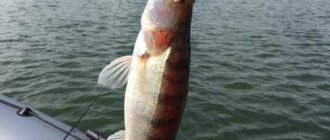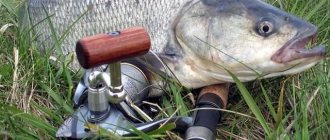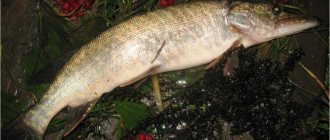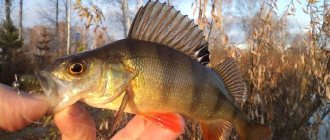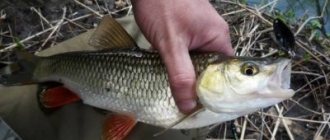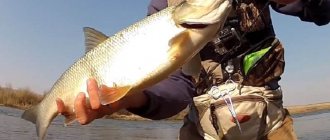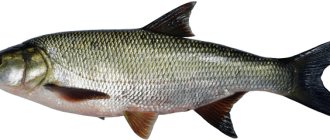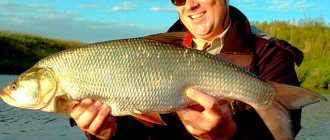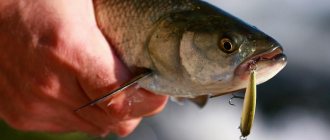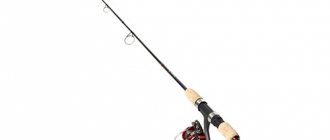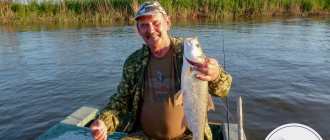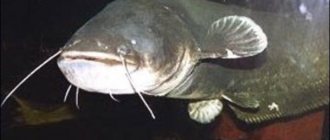Fishing for asp in the autumn is productive and interesting. A change in the behavior of fish due to cooling water and the accumulation of calories for the winter period significantly increases its activity, and, consequently, the angler’s ability to get a significant trophy on his record. But careful and strong fish for most spinning anglers remains the ultimate dream in their catches, due to certain difficulties in fishing directly related to its habits, which need to be studied before planning a fishing trip.
We will highlight the nuances of conducting such fishing sessions in the following article, the information of which will help the fisherman successfully solve the problem of catching asp in the fall using a spinning rod.
Catching asp in autumn using spinning rod
Despite the fact that the asp (also known as sheresper or river horse) is a type of carp fish, in reality it is a real predator, preferring to eat young fish, which it stuns with its tail and collects from the surface of the water. Catching asp in the fall with a spinning rod can vary significantly depending on the month. In September it begins to gather in large schools; in October there is a high chance of catching trophy fish; in November it can make forays into shallow water. Catching a large asp is considered the highest aerobatics among spinners. However, it is in the fall that every fisherman has a chance to try to catch a worthy specimen in his catch.
Fishing places and times
At this time of year, he prefers to stay near the after-rip holes, especially near areas with reverse currents. You can also find it in areas of the reservoir with an uneven bottom, where there are slight differences in depth.
With the onset of frost, the best time to catch asp in the fall is sunny, warm days with a light breeze. In such weather, the predator almost always hunts, with the only difference being that in autumn the peak of its activity occurs in the second half of the day, towards evening.
The water warms up slightly in the shallows, where the fry comes out, followed by the asp. Therefore, catching it is in some ways very reminiscent of catching pike perch in the fall. It happens that these two fish stay close to each other.
Having discovered a feeding predator, you need to outline for yourself the approximate route along which it will move. The angler's task is to move the bait beyond his path. To do this, you need a powerful rod with the ability to make long casts. It often happens that you have to fish at a distance of over 70 meters.
At times the predator will let you get closer to it, but this is usually a fairly rare occurrence, especially considering that in the fall the water becomes clear. Sometimes the fisherman manages to get quite close to the asp, while watching how he continues to hunt. But this impression is very deceptive, and no matter what bait you try, he will not be caught.
Catching asp in September using a spinning rod
The beginning of autumn is a blessed time for any self-respecting fisherman, since it is in September that the feeding season begins for most fish species.
In the summer, the asp likes to feed in splendid isolation, but with the onset of September he prefers to flock together. Since it is extremely rare to see this silvery predator close to the shore, it is best to catch sheresper from a boat, on which you can not only swim further from the shore, but also visit hard-to-reach places in the reservoir, where it is not possible to get to from the shore. For example, in thick snags or among stones and rocks. Read also: Time to cook balyk from asp - the best recipe You can determine the location of the asp by the noisy splashes that it makes with its tail on the surface of the water, trying to stun the fry. After all, the asp does not have teeth, like other predators, and he has to feed mainly on small things, which fall into a stupor after a loud and sharp blow of the tail on the water. You can also get your bearings by the noisy and insatiable seagulls circling over the asp’s feeding area. Brazen birds pick up stunned fry, which hungry predators did not have time to swallow.
“On foot” spinners also have a chance to catch an asp. This can be done early in the morning near thickets of reeds, sedges or among sunken snags. As a big lover of warm water, he likes to bask in shallow water until he detects even the slightest danger from the outside and goes back to a distance inaccessible from the shore. In addition, the warmed water also attracts the attention of fry, which swim here in search of food, but instead they themselves turn into the object of hunting by a hungry predator.
This is interesting! September is when asp activity peaks. Therefore, if not a single bite has occurred for a long time, it means there are no fish here, and it’s time to turn up the fishing rods and go in search of another place. But how not to make mistakes and find what you need? You can avoid getting into trouble and choose the right fishing spot using the following signs, which can be detected even by inexperienced fishermen:
- at the boundaries of fast and slow currents;
- in places of return flows formed by the collision of water flows with various obstacles;
- on sand spits;
- on smooth exits to coastal beach areas, where the water has time to warm up during the day in the last rays of the cooling sun and thereby attract juvenile fish;
- near snags;
- near fallen trees;
- in places of water cycles formed by the meeting of two opposite currents;
- in the pools.
Tactics and fishing techniques
Depending on the time of year, the specific fishing location and fishing habits, you can choose one of several tackles - fly fishing, spinning rod, float rod. Regardless of which gear you prefer, you need to know the subtleties to increase the likelihood of successful fishing.
Tips for a fisherman: How to catch an asp in the game real fishing - Features of choice
Fly fishing
Having arrived on shore, you need to develop a suitable plan of action. At the beginning of summer, the predator gathers in schools, driving the fry, and collective hunting is used, which shows the high level of intelligence of the fish. By finding a cauldron (a place where a school of asp drives the fry) and throwing gear there, you can count on a good catch. In such cases the bite follows immediately. If you can’t find the boiler, you need to cast the fly onto the rapids, and not into the active stream of the current, but to the border where the flow is not so rapid.
Many fishermen disagree on whether the asp takes the fly right away or waits until the current brings it under his nose. Try both options - let the bait move with the flow of water, without relaxing for a second - be prepared for a sharp hook.
Spinning
There are no preferences in choosing fishing line. Monofilament, braided - depends on habits. The optimal diameter is 0.2-0.3 mm. This fish does not have sharp teeth like pike perch or pike, and a metal leash is not needed. As bait for catching asp, it is advisable to have several baits on hand - the preferences of the predator change sharply and unexpectedly. A spoon that caught a great bite a week ago may turn out to be useless today.
The castmaster for asp is popular - due to its large weight, it can be thrown over a considerable distance. Bombarda, known as sbirulino, performed well. A large float pulls the bait, which in strong currents and shallow depths jumps over the rocks, like a fish looking for edible insects. The asp probably won't resist. Vladimir Struev talks interestingly about this bait in the video below.
Experienced fishermen do not forget proven spoons. A spoon weighing 30-45 g helps out in cases where other baits are useless. A small wolfer can also be a good choice.
You should approach fishing carefully. For example, when hunting for pike, fans of spinning rods try fishing through different layers of water. If the target is an asp, it makes sense to give preference to the upper and middle wires - he rarely hunts below. Therefore, after casting the bait, either start retrieving it immediately or after a second so that the spoon or castmaster does not have time to lie on the bottom.
Catching asp in October with a spinning rod
The best place to find asp in October is a smooth transition from great depths to a sand spit. River horses gathered in flocks come here in search of bleak, minnows and other small creatures that come to bask in the shallow water and look for food in the sand. You can also find asp in the following
- in steep whirlpools;
- among flooded snags and trees standing in the water;
- in the pits;
- in areas with an uneven bottom;
- near coastal edges;
- next to a bank that abruptly drops down at medium and great depths;
- next to islands of remaining vegetation.
In October, asp is fickle. His bite can last for twenty to thirty minutes and then suddenly stop for a couple of hours. On average, during a daylight hours there are five to seven asp outings to feed. You can count on a successful catch from dawn until lunch (the peak of the bite falls at 10-11 a.m.), then there is a long lull. The asp's next appearance in search of food may resume only in the late afternoon. The most successful fishing will be on a windy day, when light ripples or waves are walking along the surface of the water. Thanks to them, the fisherman will be invisible to the timid asp. On such days, the sheresper not only takes artificial bait better, but also comes closer to the shore, which benefits the “on foot” spinning fisher, who is deprived of the opportunity to hunt for his favorite fish from a boat.
You can detect a flock of sheresper by the usual landmarks - the loud slap of the tail on the water and the seagulls circling over the predator's feeding area. True, with the onset of the first cold snap and the sharp cooling of the water, these rules work less and less often. This is due not only to the predator’s retreat to depth, but also to the fact that it has practically nothing to do at the surface of the reservoir, since insects no longer fall into the water, and the fry are looking for other feeding places. Basically, they sink to the bottom, where small crustaceans and insect larvae can still be found. Some anglers successfully catch asp in October even without any landmarks, standing on a boat on the very fairway of the river. Bites occur in mid-water or near the surface.
Fishermen without a boat must follow the basic principles of camouflage - do not make noise on the shore, do not wear bright clothes, and do not make sudden movements. Only in this case will they have a chance to bring home several long-awaited asps.
Autumn fishing technique
Autumn fishing for asp using basic artificial baits is not much different from summer. The only exception is fishing with a wobbler on the so-called boilers. With the arrival of autumn, the asp begins to gather in flocks and reveals itself with characteristic splashes on the surface, attracting the attention of hungry seagulls. The most important thing is to secretly get close to such a boiler and stay so that the fish does not notice you. The distance should be approximately 40-50 m, so take care of the range of your gear. The wobbler must be floated downstream through the boiler and returned back with slow wiring. If you are careful and don’t scare off the sheresper, catchy fishing is guaranteed.
In general, when fishing in the fall, the wiring should not be as intense as in the summer. As the temperature drops, you should fish lower layers of water, paying attention to places with return lines, riffles, and snags. At this time you can count on trophy specimens. The place of active feeding will always be gently sloping sand spits, where the asp rushes for small fish - the basis of its diet. The weather does not particularly affect the sheresper's bite, but warm, sunny days are more favorable for it. Despite the fact that the asp’s favorite places are mainly located near land, smaller individuals can also be caught in the center of the river. Due to competition with larger relatives who occupy hot coastal spots, they have to go in search of small prey closer to the middle line, often going quite deep. In this case, you can use a leisurely jig with good amplitude, periodically tapping the bait on the bottom. The asp is perhaps the only predator on whom nature played a strange joke, depriving it of the main weapon of all hunters - teeth. More precisely, it has teeth, only pharyngeal ones, like all cyprinids, but there are no external ones. This explains his hunting style and interest in weak fish, which he, breaking into the school and performing his maneuver, disorients and eats.
Fishing for asp in November using a spinning rod
In November, it becomes more and more difficult to find an asp every day.
It goes to depth or stands at half-water. This means that there will be no loud splashes, tail strikes on the water, and seagulls, who with their clamor always correctly indicated the place of the predator’s fight. Fishing will be promising only for those spinning anglers who have a good knowledge of the specifically chosen body of water - where there are deep areas, promising edges, returns, feeding areas for fry, etc. But on the other hand, such fishermen’s catch will be quite decent - large sheresper fish are quite persistent in their search for food in November. Deprived of their usual food supply, they will grab any bait they like with a 100% guarantee of being hooked. This means that even though the bites will be rare, they will always be effective. Pay attention! The easiest way to find an asp in November is by boat, using an echo sounder. The device will accurately show not only the presence of a hole or edge, but also the presence of fish in a particular place. Most often, the sheresper will stand in the current, where it is engaged in the so-called “gill ventilation procedure.” The river horse, which has grown fat throughout the fall, will become less and less likely to go out in shallow water in search of food, preferring to stay in the depths. His visit to the sandbars will be brief and short-lived. Only the most patient and persistent fishermen can count on successful fishing here, ready to wait for the asp to come out for several hours in a row, unsuccessfully throwing one proven bait after another into the water.
It will generally be possible to catch a sheresper only from a distance of over 40 meters. He's unlikely to let you come any closer. As soon as a cautious asp suspects the slightest danger, he will immediately disappear in an unknown direction and the likelihood that he will risk returning will be negligible. The best time to hunt for a silvery predator will be sunny, warm days with a gentle breeze driving light ripples across the surface of the water.
Advice! The closer winter is, the lower the activity of the asp. However, do not despair - as long as the surface of the reservoir is not covered with ice, there is always a chance to catch this predator. In addition, the November sheresper is not a summer “small thing”. The end of autumn is perhaps the best period for catching truly trophy specimens, which, unlike their smaller relatives, require a much larger supply of fat, which means they will feed until the last, grabbing everything that floats past their nose and attracts their attention.
Lures for asp in autumn
The favorite bait for catching asp is considered to be a castmaster with holographic stickers on the cut lines, which shimmer in different colors in the sunlight and attract the attention of the feeding predator. However, he does not hesitate to grab a wobbler, spoon or spinner. In this case, it is better to choose a floating wobbler, small in size (from 2 to 8 cm) and with a depth of no more than one and a half meters. The color of the bait is silver with black, green or blue additional colors in the form of spots or stripes on the “back” and “tummy”.
Read also: Rating of the Top 10 best baits for asp
Of the spinners, it is still better to give preference to noise options that can attract the attention of a predator at a great distance. Dull, polished, oblong-shaped vibrators also performed well. In early and mid-autumn, asp feeding near the surface of the water are well caught on poppers.
Often, you can increase the effectiveness of bites by simply replacing the tees on the bait with doubles. This is due to the fact that the asp has a small mouth, and it will be much easier for him to swallow a double than a tee. For greater catchability, castmasters can be equipped with a wabik fly, the presence of which will significantly increase the number of bites.
Asp behavior in the autumn season and fishing depending on the month
With the arrival of the first autumn cold snaps, the habits of fish change.
Fish that stay near the top of the water all summer, in the fall, swim to deeper places where the water does not cool so quickly. Therefore, they lead an active lifestyle until winter. Important! Autumn water becomes clear, and catching asp becomes more difficult, since now he can see the angler from afar. Therefore, for productive fishing, special camouflage is required.
September
Asp fishing in September. The asp hunts alone all summer, and in September these fish form schools. It is more comfortable to fish this month from a boat, since with its help it will be easier to get into inaccessible areas (underwater snags and stones), where asp like to be found in the fall. Its location can be determined by splashes of water, as well as by flocking seagulls. The stunned fish, but not eaten by the asp, are treated to seagulls in its places of residence. Asp are caught in the month of September in most cases using a spinning rod, with a rod length of more than 3 meters. It is better to use fishing line No. 0.2-0.25. Some fishermen use braided line. Fish can be caught well with wobblers, castmasters, and spinners. When fishing with a wobbler in September, it is advisable to use its floating type, with which it is possible to fish in reservoirs with a large number of snags. The best length of the wobbler used is from 0.2 to 0.8 cm, with a working depth of approximately 1.5 meters. The color of the bait should be silver with the presence of black or green-blue.
Photo 2. An asp can also be tempted by a minnow wobbler.
October
Fishing for asp in October using a spinning rod is the best time for catching huge fish. Sand spits that go down under the water seem to be good areas for fishing. In October, the bulk of the fish live in them, which becomes food for the asp. At this time, he is actively busy eating and his diet is more than 5 times a day. One meal lasts 10-20 minutes, and in the morning it can take up to 40 minutes. Therefore, at this time you can make a good catch. Especially active taking of bait is observed from early morning until 10-11 o’clock, and in the evening until sunset.
Main types of bait in October:
- In October, the same baits are used for fishing as in September. Devons are presented as a new bait suitable for fishing in October. Their distinctive feature is their easy access to shallow water layers and their ability to cast far.
- In addition, wobblers, especially floating models, performed well during the period of movement with the current.
- Sinking wobblers are used when fishing at different depths.
- Diving wobblers are used for trolling.
The best capture of the bait is observed with small water ripples, thanks to which the angler becomes invisible to the fish.
Photo 3. This handsome guy pecked at the turntable.
November
Asp fishing in November. In cold November, the asp mostly goes to the bottom. At this time, it moves to the shallowest water zones only for the purpose of obtaining food. In addition, asps can often be found standing in places with strong currents. The characteristic features of fishing and the gear used are identical to the October set. Like other fish, the asp, with the arrival of frost, noticeably reduces its own vital activity. Therefore, to fish the November asp, you need to have good patience and consistency, which will undoubtedly help achieve your goal.
Tackle for asp fishing in autumn
It is better to choose a spinning rod for asp fishing with a semi-fast action. The most optimal lengths:
- When fishing from a boat - up to two meters;
- When fishing from the shore - up to three meters.
It is better to give preference to plug rods made of carbon fiber. They are not only reliable, but also lightweight and will not overload your hand during frequent recasts.
The reels are inertia-free with a large gear ratio and a high-quality line-laying mechanism. It is desirable to have a friction clutch, since the asp is a strong fish and can break the fishing line or break the rod at the very first tugs. The fishing line is colorless monofilament up to 0.25 mm in diameter, or better yet, braided with a cross-section of no more than 0.15 mm.
